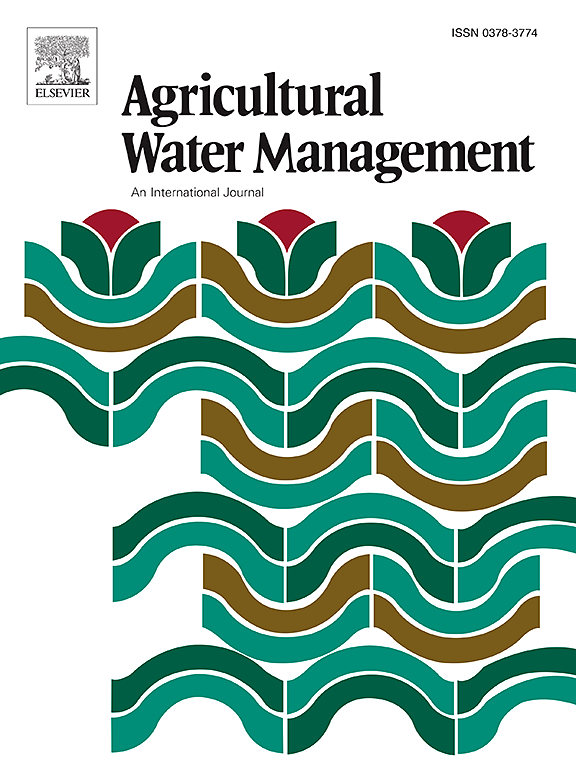不同轮作条件下处理废水灌溉对农艺作物土壤性质、养分吸收和产量的影响
IF 6.5
1区 农林科学
Q1 AGRONOMY
引用次数: 0
摘要
全球农业部门作为最大的用水者,面临着与淡水短缺和质量有关的严峻挑战。经过处理的废水(TWW)灌溉是一种可行的解决方案,促使本研究在伊朗卡拉伊的Hashtgerd和Mahdasht进行了为期两年的试验(2020-2021年),在不同的生长季节检查其对土壤和作物的影响。小麦、大麦、苜蓿和玉米在每个地区的两个农场种植。研究结果显示,TWW对电导率(EC)、养分水平(氮和磷)和重金属动力学有显著影响,这些影响因TWW质量和土壤性质而异。土壤EC在Hashtgerd和Mahdasht分别增加了1.08和1.38 dS/m和3.36和3.20 dS/m,反映了TWW组成的区域差异。与基线水平相比,Mahdasht的硝酸盐浓度增加了25 mg/kg,而两个地区的铅积累仍低于临界阈值。这些区域特定值反映了当地水质和土壤特征的变化,有助于更广泛地了解TWW灌溉结果的空间差异。TWW虽然使土壤富含氮和磷等营养物质,但也带来了盐碱化、硝酸盐浸出和重金属积累等风险,特别是在废水质量较低的Mahdasht。在TWW灌溉下,玉米和大麦的作物生产力有所提高,但小麦和苜蓿的结果不一致,包括偶尔的产量下降和营养失衡。虽然农作物中的重金属大部分仍在安全范围内,但镍和铅呈现出令人担忧的趋势。这些发现强调了TWW在提高土壤肥力和作物生产力方面的双重作用,同时也提出了环境和健康挑战。本文章由计算机程序翻译,如有差异,请以英文原文为准。
Effects of treated wastewater irrigation on soil properties, nutrient uptakes, and crop yields of agronomic crops under different crop rotations
The global agricultural sector, as the largest consumer of water, faces critical challenges related to freshwater scarcity and quality. Treated wastewater (TWW) irrigation presents a viable solution, prompting this study to examine its effects on soil and crops over a two-year experiment (2020–2021) in Hashtgerd and Mahdasht, Karaj, Iran, across different growing seasons. Wheat, barley, alfalfa, and maize were cultivated in two farms per region. Findings revealed significant impacts on electrical conductivity (EC), nutrient levels (nitrogen and phosphorus), and heavy metal dynamics, varying based on TWW quality and soil properties. Notably, soil EC increased by 1.08 and 1.38 dS/m in Hashtgerd farms, while Mahdasht saw rises of 3.36 and 3.20 dS/m, reflecting regional disparities in TWW composition. Nitrate concentrations in Mahdasht increased by up to 25 mg/kg compared to baseline levels, while lead accumulation remained below critical thresholds in both regions. These region-specific values reflect local variations in water quality and soil characteristics, contributing to a broader understanding of spatial differences in TWW irrigation outcomes. While TWW enriched the soil with nutrients like nitrogen and phosphorus, it also posed risks such as salinization, nitrate leaching, and heavy metal accumulation, especially in Mahdasht, where wastewater quality is lower. Crop productivity improved for maize and barley under TWW irrigation, but wheat and alfalfa showed inconsistent outcomes, including occasional yield declines and nutrient imbalances. Although heavy metals in crops remained mostly within safe limits, nickel and lead exhibited worrisome trends. These findings emphasize the dual role of TWW in improving soil fertility and crop productivity while presenting environmental and health challenges.
求助全文
通过发布文献求助,成功后即可免费获取论文全文。
去求助
来源期刊

Agricultural Water Management
农林科学-农艺学
CiteScore
12.10
自引率
14.90%
发文量
648
审稿时长
4.9 months
期刊介绍:
Agricultural Water Management publishes papers of international significance relating to the science, economics, and policy of agricultural water management. In all cases, manuscripts must address implications and provide insight regarding agricultural water management.
 求助内容:
求助内容: 应助结果提醒方式:
应助结果提醒方式:


